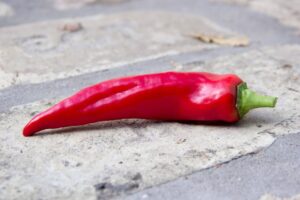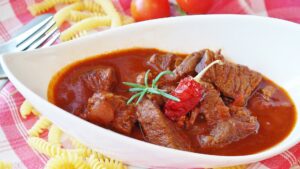When one thinks of Hungarian food, the vibrant red hue of paprika often comes to mind. This spice is not only a staple in many traditional dishes but also a symbol of Hungarian culinary identity. With its rich flavor profile and cultural significance, paprika has woven itself into the very fabric of Hungary’s gastronomy. In this blog post, we explore the origins of paprika, its varieties, its uses in Hungarian cooking, and why it holds such an esteemed place in the hearts (and kitchens) of Hungarians.
A Brief History of Paprika
Paprika, derived from the Capsicum annuum plant, is a spice made from grinding dried red peppers. Though it has become synonymous with Hungary, its journey began in the Americas, where it was cultivated long before European settlers arrived. The Spanish were among the first to bring chili peppers to Europe in the 16th century, and it wasn’t long before they found their way to Hungary. According to historical accounts, paprika was first introduced to Hungary in the 17th century. Initially, it was used as a decorative plant and medicinal herb. It took some time for it to gain popularity as a culinary ingredient. By the 19th century, paprika had firmly established itself as an essential spice in Hungarian cooking, and its cultivation became widespread, particularly in regions like Szeged and Kalocsa.

Paprika was first introduced to Hungary in the 17th century
Varieties of Paprika
One of the fascinating aspects of paprika is its diversity. While it is often perceived as a single spice, there are several varieties, each with its own unique flavor profile and heat level. The most common types of Hungarian paprika are:
Sweet Paprika (Édesnemes): This is the most widely used type in Hungary. It has a mild flavor and a brilliant red color, making it perfect for adding depth to dishes without overwhelming heat.
Hot Paprika (Csípős): As the name suggests, this variety has a kick. It’s used sparingly in recipes where a bit of heat is desired.
Smoked Paprika (Füstölt): This type is made from dried peppers that have been smoked over an open flame. It adds a unique smoky flavor to dishes and has gained popularity beyond Hungarian cuisine.
Specialty Paprika: There are also various specialty paprikas, often blended with other spices or herbs for specific recipes. For instance, some might include a hint of garlic or onion, enhancing the overall flavor profile.
Paprika’s Place in Hungarian Cooking
Paprika is much more than just a spice; it is the heart and soul of Hungarian cooking. It’s used in a multitude of dishes, ranging from soups and stews to meats and sauces. Let’s take a closer look at some classic Hungarian dishes that showcase the versatility of paprika:
Goulash (Gulyás): Perhaps the most famous Hungarian dish, goulash is a hearty soup or stew made with beef, vegetables, and, of course, paprika. The sweet paprika is essential for giving the dish its signature color and flavor. A well-made goulash is a perfect example of how paprika can transform a simple dish into something extraordinary.

Pörkölt is similar to goulash but is thicker and often made with pork
Pörkölt: This meat stew is similar to goulash but is thicker and often made with pork or chicken. The depth of flavor in pörkölt comes from the generous use of sweet paprika, which is sautéed with onions before adding the meat and other ingredients.
Lecsó: A traditional Hungarian ratatouille-like dish, lecsó is made with tomatoes, peppers, onions, and paprika. It can be served as a side dish or as a main course, often accompanied by bread or rice. The vibrant colors and the sweet, smoky flavor of paprika make lecsó a beloved summer dish.
Stuffed Peppers (Töltött Paprika): Bell peppers are filled with a mixture of rice and meat, then cooked in a rich tomato sauce flavored with paprika. This dish beautifully showcases how paprika enhances the overall flavor profile of a meal.
Fisherman’s Soup (Halászlé): A spicy fish soup that is a must-try for seafood lovers, halászlé is made with freshwater fish, tomatoes, and plenty of paprika. The soup’s vibrant red color is a testament to the generous amount of paprika used, providing both flavor and visual appeal.
The Cultural Significance of Paprika
In Hungarian culture, paprika is more than just a culinary ingredient; it is a source of national pride. The spice has become a symbol of Hungarian identity, and its production is celebrated throughout the country. Annual paprika festivals take place in regions known for their paprika cultivation, particularly in Szeged and Kalocsa. These festivals feature tastings, cooking demonstrations, and competitions, showcasing the many ways paprika can be used. The quality of Hungarian paprika is also highly regarded. It is often sought after by chefs and home cooks alike, not only for its flavor but also for its vibrant color. The spice is typically sold in different grades, with the highest quality being a deep red color and rich flavor.
Cooking with Paprika
When cooking with paprika, it’s important to remember a few key tips to make the most of this flavorful spice:
Add Paprika Early: To fully develop its flavor, it’s best to add paprika early in the cooking process. Sautéing it with onions or garlic releases its essential oils and enhances its taste.
Avoid High Heat: Paprika can burn easily, especially the sweet variety. Always use moderate heat when cooking with paprika to prevent bitterness.
Store Properly: To maintain its flavor and color, paprika should be stored in a cool, dark place, ideally in an airtight container. It’s best to purchase paprika in small quantities to ensure freshness.
Experiment: Don’t be afraid to experiment with different varieties of paprika. While sweet paprika is a staple, incorporating hot or smoked paprika can add exciting new dimensions to your dishes.

Hungarian house decorated with paprika
Paprika is undoubtedly a cornerstone of Hungarian cuisine, infusing dishes with its vibrant color and complex flavor. From goulash to lecsó, the spice plays a pivotal role in defining the essence of Hungarian cooking. Its rich history, cultural significance, and versatility in the kitchen make paprika a beloved ingredient among Hungarians and food enthusiasts worldwide.

